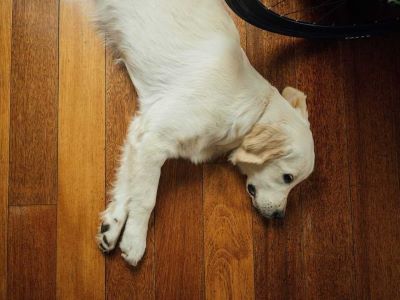You may wonder “What is colitis in dogs?“🐶 In colitis dog’s tummy is throwing temper tantrums. This is not as rare as you may think. Many dogs have this issue, and it is quite important to look out for it.
When left untreated,🏥 it can make your dog really uncomfortable and this can lead to more complex issues. But don’t sweat we are here to make you understand what is colitis in dogs and how can you manage it to keep your dogs happy and healthy.❤️🩹

What Is Colitis in Dogs?
Colitis in dogs is a condition where the large intestine (the part of the digestive system responsible for soaking water and forming stools) becomes irritated and inflamed.
This inflammation can lead to a range of digestive problems and discomfort for our dogs. Now let’s see some causes of Colitis in Dogs:
- Dietary Factors: Colitis can be triggered by the food your dog eats. If their diet🍲 isn’t suitable or they suddenly eat something that doesn’t agree with them, it can upset their tummy and cause colitis.
- Infections: Sometimes, bacteria🦠 or parasites can make their way into a dog’s digestive system and cause an infection. This infection can lead to colitis, causing symptoms like diarrhoea and abdominal discomfort.
- Stress: Just like in humans, stress can affect dogs too. Stressful situations, changes in routine, or anxiety can upset their digestive system, leading to colitis.

- Allergies: Some dogs can be allergic to certain ingredients in their food or environmental factors like pollen.🥀 Allergies can trigger inflammation in the intestines and result in colitis symptoms.
- IBD: Inflammatory Bowel Disease is a more chronic condition where the dog’s immune system mistakenly attacks their own gut.
“Colitis will commonly display as diarrhoea or loose stools which will usually contain fresh blood and mucus. Additionally, these stools may be difficult to pass and can cause pain when toileting, this requires special attention and treatment”, says the expert at Purina.
Symptoms of Colitis in Dogs
Colitis often leads to frequent, loose, and watery stools. Dogs with colitis may struggle to control their bowel movements, causing messy accidents in the house🏠 or during walks. One noticeable sign of colitis is the presence of blood in a dog’s stool.
It can range from small traces to more significant amounts, indicating inflammation and irritation in the colon.
Dogs with colitis may experience discomfort or pain in their belly. They may show signs of this through restlessness, whining, or reluctance to be touched around the abdominal area. Colitis often causes dogs to need to "go" more frequently⌛ than usual.
They may repeatedly ask to go outside or seem restless as they try to find relief. Tenesmus means your dog is really trying hard to poop, but not much or nothing comes out[1]. It’s because their inflamed colon makes them feel like they need to go, but they can’t.

Diagnosis of colitis
When your dog has symptoms of colitis, the first step is a thorough physical check-up by the vet.👨⚕️ They will feel your dog’s abdomen, looking for tenderness or discomfort. The vet may also assess your dog’s overall health and condition.
1. Fecal Analysis
The vet will examine a sample of your dog’s poop (stool) to look for any signs of infection,🦠 parasites, or unusual things. This helps to identify the cause of colitis.
2. Blood Tests
Blood tests can reveal if there are any signs of infection, inflammation, or other abnormalities in your dog’s body. Abnormal blood cell counts or specific markers in the blood🩸 can provide important clues.

3. Imaging (X-rays, Ultrasound)
X-rays and ultrasounds are like special pictures of the inside of your dog’s body. They can help the vet see if there are any physical issues in the intestines, such as blockages or thickening of the intestinal walls.
4. Endoscopy and Biopsy
In some cases, the vet may need to take a closer look inside your dog’s intestines. They do this using an endoscope, which is a tiny camera on a flexible tube. This can help diagnose conditions like IBD. If necessary, the vet might take a small sample (biopsy) of the tissue for additional study.
Treatment
Adjusting your dog’s diet can play a significant role in managing colitis. The vet may recommend a special, easily digestible diet🥣 or a prescription diet that’s gentle on the stomach. This dietary change can help reduce irritation in the colon.
Medications
If an infection is causing colitis, antibiotics can help eliminate the harmful bacteria. Medications💊 like steroids or other anti-inflammatory drugs can reduce the inflammation in the colon, relieving discomfort.
Probiotics are like friendly bacteria that can be added to your dog’s diet. They help balance the gut flora, promoting a healthier digestive system and reducing📉 inflammation.

Surgery
In rare, severe cases of colitis that doesn’t respond to other treatments, surgery may be necessary. Surgery can involve removing the affected part of the intestine or addressing other issues contributing to the condition.
Additionally, Stress management is essential for dogs with stress-induced colitis. Reducing environmental stressors and ensuring a calm, comfortable atmosphere can be helpful.
Prevention
Feeding your dog a high-quality, well-balanced diet🥣🍗 is essential for preventing colitis. Ensure the food you choose is appropriate for your dog’s age, size, and any specific dietary requirements.
Avoid sudden changes in their diet, as this can trigger digestive issues. Dogs can be sensitive to changes in their environment or routine, so try to keep things as consistent as possible.📊
Provide a safe, comfortable space for your dog to retreat to when they feel anxious, and consider using positive reinforcement training to build their confidence. Regular visits to the vet👨⚕️ are vital in preventing and detecting colitis early.
FAQs
How Do You Prevent Colitis in Dogs?
Make sure your dog eats a well-balanced diet and don’t feed your pooch unhealthy food and treats. Train Fido to “leave” anything he is tempted to eat off the ground when you take him for a walk. Consistently feed your dog the same well-balanced diet and avoid sudden changes.
What Not to Feed Dogs With Colitis?
Avoid feeding your dog fatty meats, dairy products, and fried foods. High-fibre foods: While fibre can be beneficial for managing colitis, very high-fibre foods can also cause digestive upset and worsen symptoms in some dogs. Avoid feeding your dog foods that are very high in fibre, such as beans, and legumes.
What Is Colitis in Dogs?
Colitis in dogs is a condition that refers to the inflammation of the large intestine or colon. It will commonly display as diarrhoea or loose stools which will usually contain fresh blood and mucus. Additionally, these stools may be difficult to pass and can cause pain when toileting.
How Long Does Colitis Last in Dogs?
Chronic colitis causes an ongoing display or recurrent bouts of symptoms that typically last two to four weeks. The condition can be chronic (episodic), meaning that it comes and goes in repeated waves, or chronic (constant). Either case can be very taxing and lead to secondary health problems in dogs.
Summary
In conclusion “What is colitis in dogs?“🐶 It can happen because of their food, infections, or if they’re feeling stressed or have allergies.
When they have colitis, they might get a runny tummy, a bit of blood in their poops, and their tummy can hurt. So, what’s important is spotting this early and helping them feel better. That’s where you, as a loving pet owner,🐾 come in.
Make sure you feed them good food, keep them happy to reduce stress, and regularly visit the vet to keep an eye on their health. By taking good care of your dog, you’re ensuring they’re as happy as can be!💖
Reference:
- What to know about Tenesmus. (2021, May 28). WebMD.



